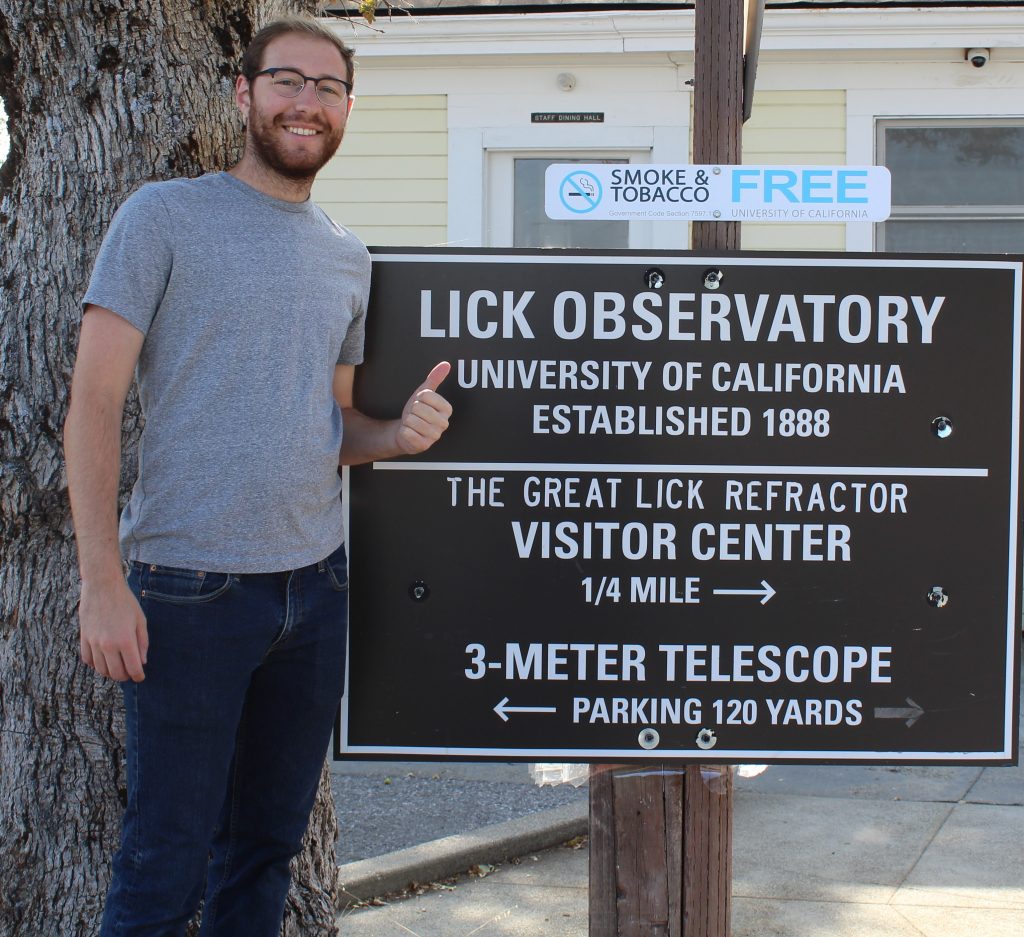Jack Lubin is a 3rd year Physics Ph.D. student studying exoplanets who recently gave a talk at the 237th AAS meeting in January about his research and upcoming paper. Jack works with Dr. Paul Robertson’s research group here at UCI as part of a larger team across all of UC, Caltech, and University of Hawaii called the TESS-Keck Survey (TKS). TESS (Transiting Exoplanet Survey Satellite) is finding thousands of planet candidates via the transit method which tracks a star’s brightness over time. The brightness of the star will dip if an orbiting planet passes in front of our line of sight. One star they have followed up extensively is HD191939, which has 3 transiting planets and 2 newly discovered non-transiting planets. In addition to his talk at AAS, Jack is leading the paper on this system. The paper will be publicly available soon, so keep an eye out!
Jack and his team follow up TESS planet candidates with the Keck Telescope in Hawaii to measure the RV’s (radial velocity curves) of host stars in an effort to measure the masses of the transiting planets. In the case of HD191939, which had 3 transiting planets identified by TESS data, they ended up identifying 2 additional non-transiting planets in the RV curves. Jack and his team extracted tight constraints on the masses for 4 of the 5 planets. Jack is also able to describe the possible compositions of the planets as well as do a few dynamical studies of the system. Using TTVs (transit time variations) which measure planet-planet interactions, they were able to constrain the inclination of one of the non-transiting planets using Laplace-Lagrange secular perturbation theory, something that is not often done in a discovery paper. They also came up with a new technique to constrain the mass and period of a planet that does not complete a full orbit during the baseline of their observations. Overall, Jack says he had a lot of fun working on this project and says more importantly has learned a ton about orbital mechanics and dynamics of planetary systems.
Jack describes his paper as a type of Q&A style, where they would start each section by literally asking a question out loud and then answer it in the text of that section. Jack and his team asked a lot of questions along the way and wrote up the most interesting ones, but Jack says there is so much more to this work that they explored. He says this is the kind of system that is going to be observed by all sorts of different teams interested in different science cases, so the story of these planets is definitely not complete. Jack hopes to continue working on the system in the future.
The 237th AAS was Jack’s first AAS meeting, and while he wishes it wasn’t virtual, he still got a lot out of attending the meeting. It was a 5 minute talk so Jack says he wasn’t able to get into too much detail which made putting the slideshow together extra difficult. Nonetheless, he felt the talk and the questions at the end went smoothly. The best advice he got beforehand was about the timing of the talk. Since it was only 5 minutes, it is easy to rush and talk super fast because people want to share as much as they can. Instead, Jack cut the talk down to only a few absolute highlights. That way, the talk itself would stand out and it wouldn’t feel rushed to the audience. Plus, Jack notes, by holding some info back, it would make people want to read the paper to learn more!
When reflecting on his involvement in the team, Jack says he feels really lucky to be able to pick others minds and learn more about the sub-field he is getting started in. He says he learned about how much a team effort science research really is. Jack says that he is happy he has been able to draw on experience, knowledge, and guidance of some of the top exoplanet experts in the world. When asked about his research interests, Jack says he hopes to find more exoplanets. Beyond that, he is fascinated by the hindrances to exoplanet detection, such as stellar activity. Stellar Activity can create signals that either mask or masquerade as planets in RV data sets. In the early days of the field, people generally tried to avoid very active stars as a way to make planet detection easier. But now that there is more precise instrumentation, people are finding that there is no such thing as a “quiet” star, they are all noisy with activity below various thresholds. Jack says we must come up with new techniques to identify and characterize these stellar activity signals if we are to minimize false positive planet detections in the future.
Outside of work, Jack is an avid baseball fan, following the NY Yankees. Usually he will put the game on his second monitor in the afternoon. Most weekends Jack will bike down to the beach to sit on the sand and read sci-fi or nonfiction history. He says he just finished a post-apocalyptic sci-fi novel from the 60s (The Drowned World), and right now he is halfway through a biography of Alexander von Humboldt. Jack also enjoys playing golf. Currently, Jack says his work-life balance has been non-existent, working long days. He says this may not be the best way of dealing with things but it’s helped him through the year. Jack looks forward to the future, and says once people are all vaccinated he intends to take a nice vacation! He loves road trips and has been planning a big one through the national parks in the southwest: Arizona, New Mexico, Colorado, Utah, and Nevada. In the future Jack wants to continue in academia. Coming from a tech job, Jack found that he really missed the world of astronomy and science in general.


